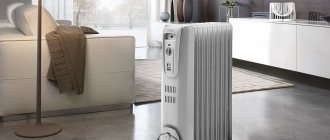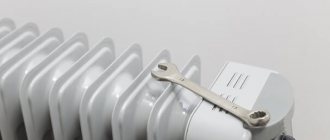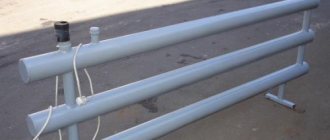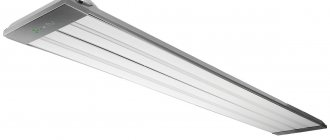When the weather outside is not pleasantly warm, and the start of the heating season is still far away, the issue of economical and high-quality heating of the room becomes acute. If you live in a private house, nothing is simpler. All you have to do is light the stove. What should residents of the multi-apartment sector do? A variety of heating devices come to the rescue. This is where a logical question arises: which is better, a convector or an oil heater? If you've never experienced either of these, there's something to think about. This is exactly what our article today will be about.
So, oil heater or convector? What's better? Reviews from experts and consumers will help you make the right choice. To find out exactly which heater is better, let's first find out the operating principle of each of them.
Operating principle of an oil cooler
Everything here is arranged quite simply. The oil cooler is a hermetically sealed reservoir filled with mineral oil. An electric heater is also located inside the structure. As a result of the operation of the heating element, the oil temperature rises, and then the walls of the tank heat up. The room is heated.
To prevent the oil from boiling, the system is equipped with a special sensor that controls the temperature. In addition, some models have horizontal control. This means that if the radiator accidentally tips over and the heating element is out of the oil environment, the automation will instantly turn off the device.
Oil radiators are very easy to use.
No knowledge is required here. You just need to plug the plug into the outlet, press the power button and move the device closer. Some manufacturers equip their models with a timer that allows the device to automatically turn on at a certain time. This is very convenient if you want, for example, to return from work to an already well-warmed room. At the same time, the radiator remains turned off throughout the day and does not waste electricity. See also -
Comparison of electric convector and fan heater
Which heater is better for constant use: oil or convector
We have outlined all the comparative characteristics of both types of heating equipment. Let’s summarize by indicating which one is ideal for regular use. In houses with many rooms, you will in any case have to acquire several devices, but electric convectors show greater productivity. These devices begin heating the room instantly, and it will be comfortable to be in the room immediately from the moment the device is turned on.
According to users, an oil cooler is slow when it comes to heating, and it is not suitable when you need to get the heat up quickly. Our editors have determined that an electric convector is best suited for continuous use during the winter season.
Equipment categories
- Kitchen appliances
- Electronics
- Smartphones
- BY
- Appliances
- TVs
- Reviews
- Ratings
Advantages and disadvantages
Based on consumer reviews, we tried to highlight the main disadvantages and advantages of such heating devices. The advantages of an oil heater include the following:
- Low cost.
- High-quality heating of the surrounding air due to the increased heat transfer area.
- "Soft" heating. If we compare with heating devices that have an open spiral, it can be noted that the oil radiator does not dry out the air. In addition, during its operation, dust particles located in the immediate vicinity do not burn. That is why no foreign odors arise during operation.
- Mobility. Since oil heaters are 98% floor-standing and have wheels, they can be easily placed in any location of your choice.
- Durability and reliable operation.
However, in addition to undeniable advantages, radiators also have disadvantages. Customer reviews also helped us discover them. So, the cons:
- Quite high t˚ C of the case. During operation at maximum power, the walls of the oil cooler can heat up to temperatures above 90 C. This fact calls for thinking about the issue of safety.
- Impressive weight. Some models of oil heaters can “pull” 25 kg, and the smallest ones rarely weigh less than 10 kg. This may create additional inconvenience when moving.
- Possibility of coolant (oil) leakage due to mechanical damage to the housing. Moreover, if this happens, the heater will simply have to be thrown away. The cost of repairs is often not comparable to the cost of a new device.
TOP 3 best oil heaters
- Timberk TOR 21.1206 BC/BCL
- Scarlett SC 21.1005 S/SB
- Polaris CR 0512B
See also -
Rating of the best oil heaters based on user reviews
Secrets of a successful purchase
To avoid making a mistake with your choice, follow simple rules:
- Always check the device for leaks carefully. Stores will almost always try to sell low-quality goods to customers if they notice a defect. This is done to ensure that no further problems arise after your purchase.
- If possible, take the wall or floor radiator that has more sections. The more sections there are, the faster the heater will heat the room.
- Buy modern devices. They have a reduced risk of fire, are more economical, and often have a temperature control so you can adjust the temperature to your desired temperature. You can find useful information in the article which heater is the most economical for a summer residence.
- Calculate the power correctly. Each oil radiator can heat no more than 30 square meters, so larger rooms require more convectors.
- Read reviews. In stores and on forums, people write what they liked and what they didn’t. Sometimes such information is very valuable, it allows you to understand whether a particular model will suit you.
Of course, we can talk about the choice for a long time, but we have told you the main thing. Next - your personal preferences for an apartment, house, cottage. We hope you found this article helpful. Household radiators are a huge segment of goods, and it’s really not easy to understand them. Subscribe to our blog and social networks. Recommend us to your friends and acquaintances. See you again here!
Sincerely, experts of the StroyDomEconom.RU portal!
How a convector works and works
Externally, it is very easy to distinguish a convector from an oil radiator. While the latter looks like an “accordion on legs,” the former has a flat, smooth body with slots at the top and bottom. The main difference between these devices is the method of heating the room. The radiator first heats the oil, and the convector heats the air masses directly.
The operating principle of the convector is based on the physical properties of cold and hot air. The second, as you know, is easier. In the hollow body of the convector there is only a heating element (coil) and a temperature sensor. Cold air enters the convector through slots located at the bottom of the device. Then the air masses, heated by the heating element, naturally exit through the holes located in the upper part of the housing. And their place is again taken by cold air, the process repeats.
Each convector heating device is equipped with a temperature sensor, which turns the device on and off depending on whether the air in the room has reached the set temperature. This is very convenient since there is no need to monitor the device. Automation independently maintains a comfortable temperature in the room.
Almost all convector models have two placement methods.
They can be hung on the wall or mounted on special legs and placed in a convenient place on the floor. See also -
Choosing the best electric convector for your home
Operating principle and design of panel and sectional heaters.
The heating element is a heating element immersed in mineral oil. It transfers heat to the oil, which, in turn, heats the walls of the device. Due to the high heat capacity of the oil, after a power outage, the device cools down gradually. All heaters must be equipped with a thermostat. When the set temperature is reached, the heating element turns off; when it cools down, the thermostat turns on the heating again. Using a thermostat allows you to save energy.
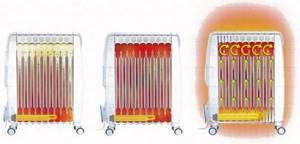
Disadvantages of the oil device:
- heavy weight;
- not warming up the room quickly enough;
The design of oil heaters can be stationary or floor-mounted. In the latter case, there are legs that allow you to roll the heater from place to place. This allows for a more flexible approach to heating problem areas of the room. The problem of the air not warming up quickly enough can be solved by purchasing an oil heater equipped with a fan. This type of oil heaters is less common.
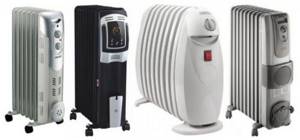
Some models even have a humidifier and a timer, including ones with remote control. It is possible to configure the heater to turn on and off at a predetermined time. For example, before arriving at the dacha, the heater will turn on in advance and bring the room temperature to a comfortable level, which is very convenient.
Advantages and disadvantages
Consumer reviews will also help us determine all the advantages and disadvantages.
Advantages:
- When using a convector, you can set the exact (literally down to a degree) temperature in the room and the automation will maintain it.
- The device body heats up no higher than 60 C, which is much safer than in the case of oil-based devices.
- With a little effort, you can connect several convectors into a common heating system. An oil-type heater works exclusively individually.
However, the convector also has its disadvantages:
- Customer reviews suggest that when using such equipment, a slight draft may occur in the room.
- The convector may not heat up rooms with high (above 3 m) ceilings very well. Warm air will “hang” under the ceiling and the device may not work efficiently enough.
- Natural convection can lead to increased movement of microorganisms and dust particles. This may be unpleasant for people susceptible to allergic reactions or diseases of the ENT organs.
TOP 3 best convector heaters
- Noirot Spot E-3 Plus 1500
- Hyundai H-HV15-15-UI618
- Ballu BEC/ETMR-1500
See also -
How to choose an economical electric boiler for heating your home
Types of oil heaters
When choosing a heater, you also need to pay attention to the design profile. It can be ribbed or flat
Ribbed
Ribbed oil heaters are shaped like the usual cast iron radiators, as they are also made of many sections. Sections of the electrical device are made by welding and further pressing. Most often, the thickness of steel can vary from 0.8 to 1 mm. Tightness is achieved thanks to laser cutting, which very accurately and evenly makes the required dimensions. High temperature also does not deform the body or joints.
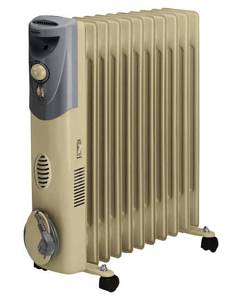
Finned Oil Heater
After the body is made, holes are cut into it, passing through each individual section. This is done for their communication with each other. Once the device is technically ready, it is painted with powder paint and then placed in an oven to polymerize the coating.
This type of housing makes the device durable and efficient, since it has more area for heat transfer. True, in this case the oil heater will have considerable weight and a fairly large structure.
Flat
Flat heaters are two plates welded together, which have recesses on the body for heating elements and oil. This device is less efficient, but it also consumes less electricity. In addition, a flat heater does not have as much weight as a ribbed one and therefore can be mounted on a wall.
A flat oil heater can be made of steel, aluminum or an alloy of these metals. Steel appliances tend to be heavier and can cause damage if dropped. Aluminum is lighter, but less powerful.
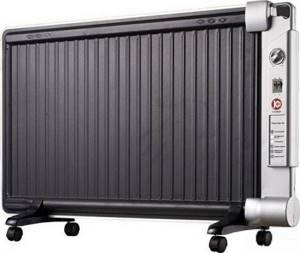
Flat heater can be wall mounted
The most expensive devices are those made of aluminum and steel.
Important! Bimetallic devices may make a cracking sound when heated or cooled. This is due to the difference in thermal expansion between steel and aluminum.
Installation Rules
- The optimal distance from the radiator to the outlet is no more than 30 cm.
- The socket should be located on the side or below the device body and in no case higher.
- There should be no obstacles or furnishings closer than 30 cm on all sides of the radiator.
- The panel should be 3-5 cm away from the wall in accordance with the manufacturer’s requirements, which must be specified in the instructions.
- Do not use an oil radiator to dry clothes or any objects. It must not be covered with a cloth or interfere with heat transfer in any way.
- It is better to supply power for a stationary heater to a separate circuit breaker in the distribution panel or to a group of fuses when using several heaters throughout the house.
It is best to install the radiator in the place of the greatest heat loss, under the window opening. Naturally, with the condition that the radiator will not be covered with heavy tulle or curtains. Otherwise, it is better to place the heater on a wall bordering the street so that nothing interferes with heat exchange.
Technical parameters of the oil device
During operation, some important requirements must be observed. The device must be stable and the cord must not be strained. Install in a place out of the reach of children or secure it. Avoid exposure to moisture. Do not operate near flammable materials. Do not use after the service life has expired.
Compliance with these rules will allow this useful device to work for a long time and bring joy to its owners.
Average score of ratings is more than 0
Share link
Comments There are no comments yet, but you could be the first...
